Analysis of Interest Rate and Foreign Exchange Risk in Banking
VerifiedAdded on 2023/05/29
|7
|1392
|55
Report
AI Summary
This report examines interest rate risk and foreign exchange risk within the context of bank financial risk management. It begins by critiquing the concept of matching asset and liability maturities as a method for immunizing a financial institution's balance sheet, highlighting the limitations of market value accounting and the importance of duration in assessing interest rate elasticity. The report then analyzes a U.S. bank's exposure to foreign exchange risk, calculating the breakeven point for currency fluctuations. Furthermore, it calculates the duration of a bond and its price sensitivity to interest rate changes. Finally, the report discusses asset transformation by financial institutions, focusing on the risks associated with differing maturities and liquidity characteristics of assets and liabilities, emphasizing the need for optimal management of interest rate risk. Desklib offers this document along with a wide array of solved assignments and study resources for students.
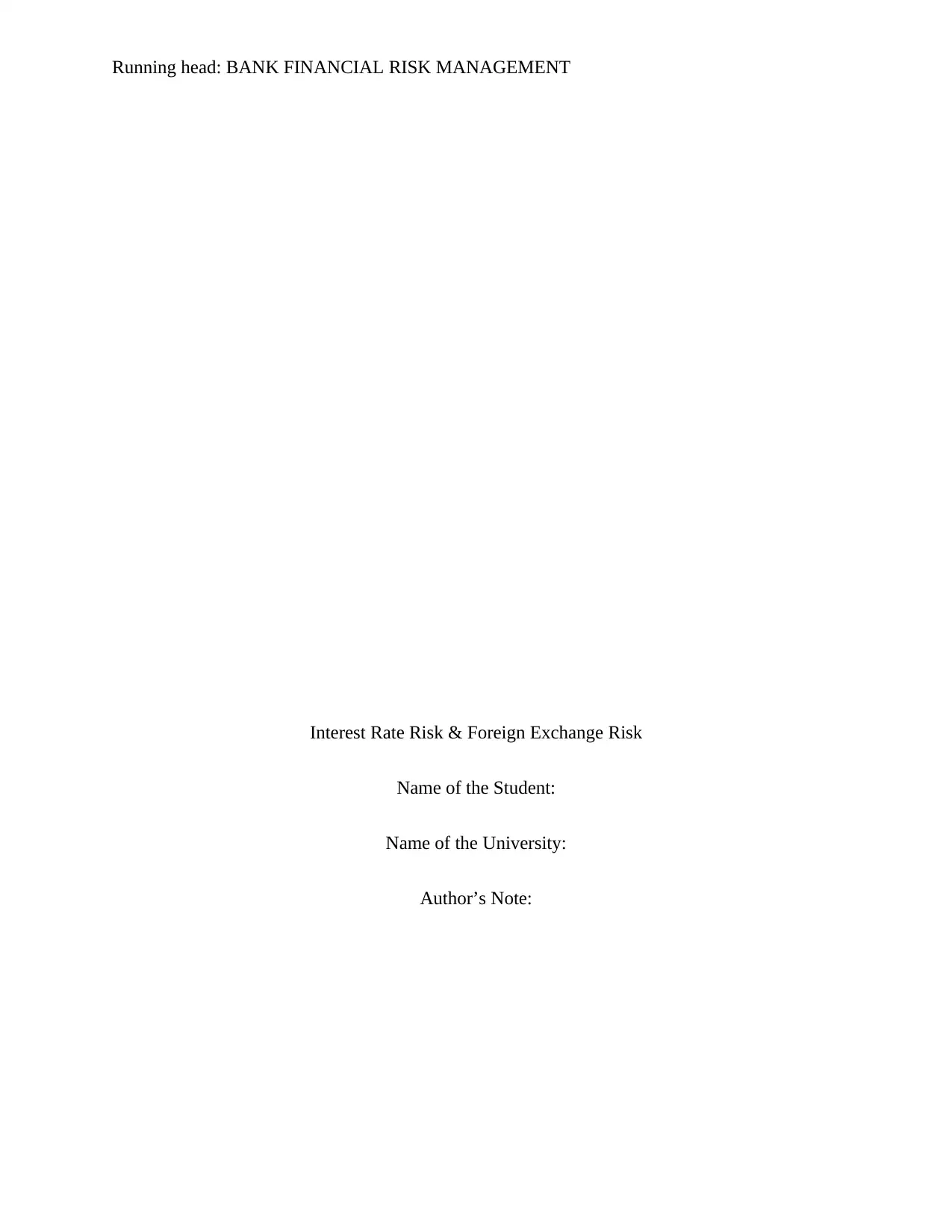
Running head: BANK FINANCIAL RISK MANAGEMENT
Interest Rate Risk & Foreign Exchange Risk
Name of the Student:
Name of the University:
Author’s Note:
Interest Rate Risk & Foreign Exchange Risk
Name of the Student:
Name of the University:
Author’s Note:
Paraphrase This Document
Need a fresh take? Get an instant paraphrase of this document with our AI Paraphraser
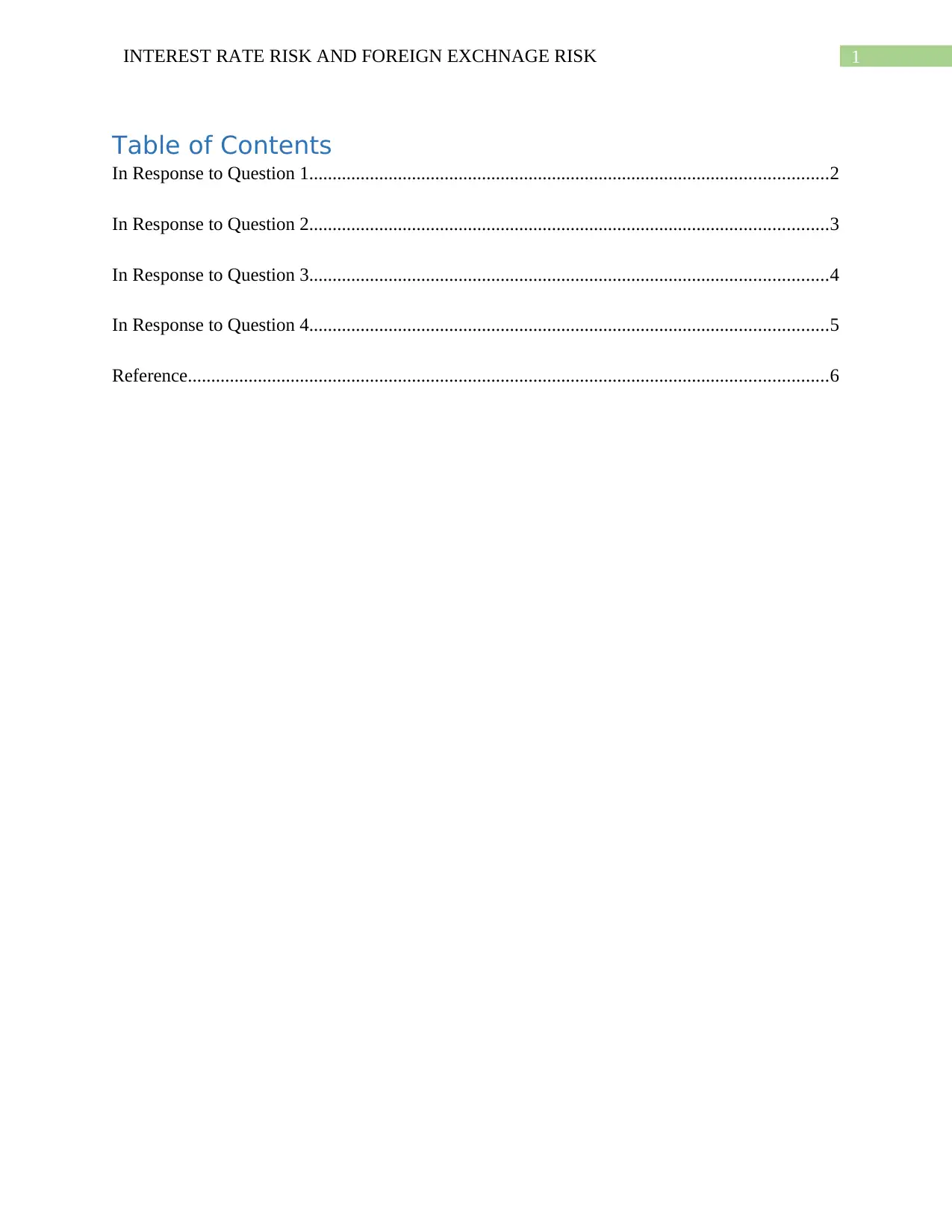
1INTEREST RATE RISK AND FOREIGN EXCHNAGE RISK
Table of Contents
In Response to Question 1...............................................................................................................2
In Response to Question 2...............................................................................................................3
In Response to Question 3...............................................................................................................4
In Response to Question 4...............................................................................................................5
Reference.........................................................................................................................................6
Table of Contents
In Response to Question 1...............................................................................................................2
In Response to Question 2...............................................................................................................3
In Response to Question 3...............................................................................................................4
In Response to Question 4...............................................................................................................5
Reference.........................................................................................................................................6
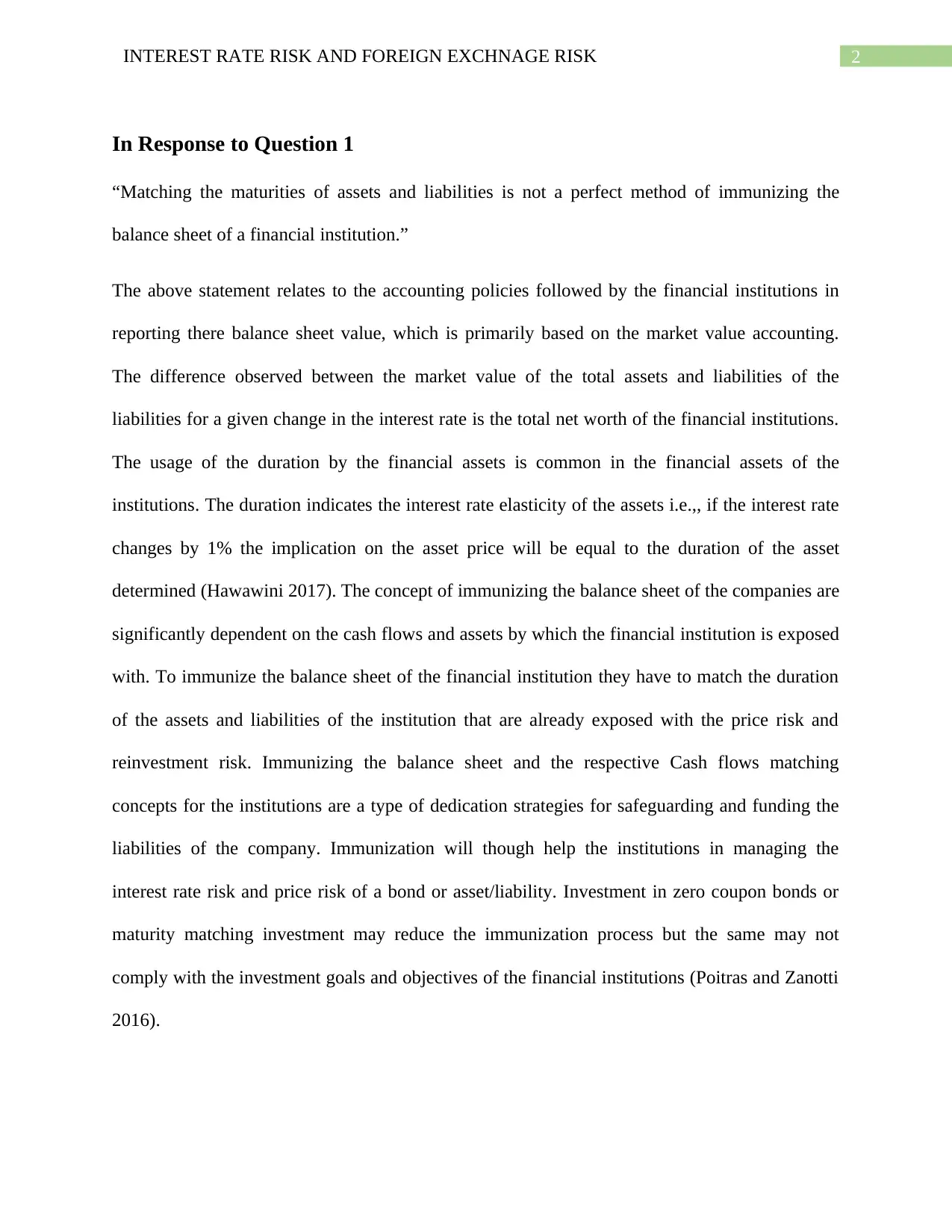
2INTEREST RATE RISK AND FOREIGN EXCHNAGE RISK
In Response to Question 1
“Matching the maturities of assets and liabilities is not a perfect method of immunizing the
balance sheet of a financial institution.”
The above statement relates to the accounting policies followed by the financial institutions in
reporting there balance sheet value, which is primarily based on the market value accounting.
The difference observed between the market value of the total assets and liabilities of the
liabilities for a given change in the interest rate is the total net worth of the financial institutions.
The usage of the duration by the financial assets is common in the financial assets of the
institutions. The duration indicates the interest rate elasticity of the assets i.e.,, if the interest rate
changes by 1% the implication on the asset price will be equal to the duration of the asset
determined (Hawawini 2017). The concept of immunizing the balance sheet of the companies are
significantly dependent on the cash flows and assets by which the financial institution is exposed
with. To immunize the balance sheet of the financial institution they have to match the duration
of the assets and liabilities of the institution that are already exposed with the price risk and
reinvestment risk. Immunizing the balance sheet and the respective Cash flows matching
concepts for the institutions are a type of dedication strategies for safeguarding and funding the
liabilities of the company. Immunization will though help the institutions in managing the
interest rate risk and price risk of a bond or asset/liability. Investment in zero coupon bonds or
maturity matching investment may reduce the immunization process but the same may not
comply with the investment goals and objectives of the financial institutions (Poitras and Zanotti
2016).
In Response to Question 1
“Matching the maturities of assets and liabilities is not a perfect method of immunizing the
balance sheet of a financial institution.”
The above statement relates to the accounting policies followed by the financial institutions in
reporting there balance sheet value, which is primarily based on the market value accounting.
The difference observed between the market value of the total assets and liabilities of the
liabilities for a given change in the interest rate is the total net worth of the financial institutions.
The usage of the duration by the financial assets is common in the financial assets of the
institutions. The duration indicates the interest rate elasticity of the assets i.e.,, if the interest rate
changes by 1% the implication on the asset price will be equal to the duration of the asset
determined (Hawawini 2017). The concept of immunizing the balance sheet of the companies are
significantly dependent on the cash flows and assets by which the financial institution is exposed
with. To immunize the balance sheet of the financial institution they have to match the duration
of the assets and liabilities of the institution that are already exposed with the price risk and
reinvestment risk. Immunizing the balance sheet and the respective Cash flows matching
concepts for the institutions are a type of dedication strategies for safeguarding and funding the
liabilities of the company. Immunization will though help the institutions in managing the
interest rate risk and price risk of a bond or asset/liability. Investment in zero coupon bonds or
maturity matching investment may reduce the immunization process but the same may not
comply with the investment goals and objectives of the financial institutions (Poitras and Zanotti
2016).
⊘ This is a preview!⊘
Do you want full access?
Subscribe today to unlock all pages.

Trusted by 1+ million students worldwide
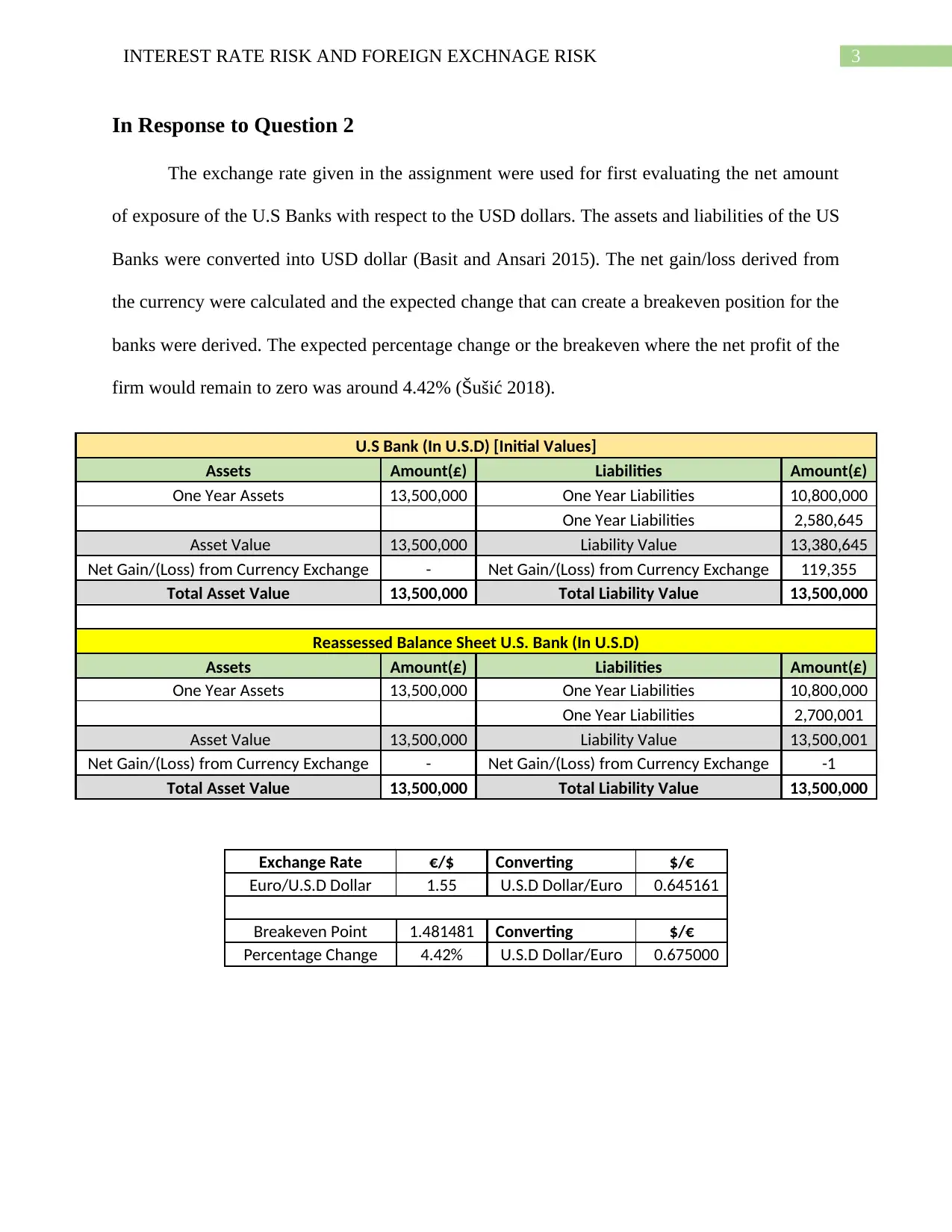
3INTEREST RATE RISK AND FOREIGN EXCHNAGE RISK
In Response to Question 2
The exchange rate given in the assignment were used for first evaluating the net amount
of exposure of the U.S Banks with respect to the USD dollars. The assets and liabilities of the US
Banks were converted into USD dollar (Basit and Ansari 2015). The net gain/loss derived from
the currency were calculated and the expected change that can create a breakeven position for the
banks were derived. The expected percentage change or the breakeven where the net profit of the
firm would remain to zero was around 4.42% (Šušić 2018).
U.S Bank (In U.S.D) [Initial Values]
Assets Amount(£) Liabilities Amount(£)
One Year Assets 13,500,000 One Year Liabilities 10,800,000
One Year Liabilities 2,580,645
Asset Value 13,500,000 Liability Value 13,380,645
Net Gain/(Loss) from Currency Exchange - Net Gain/(Loss) from Currency Exchange 119,355
Total Asset Value 13,500,000 Total Liability Value 13,500,000
Reassessed Balance Sheet U.S. Bank (In U.S.D)
Assets Amount(£) Liabilities Amount(£)
One Year Assets 13,500,000 One Year Liabilities 10,800,000
One Year Liabilities 2,700,001
Asset Value 13,500,000 Liability Value 13,500,001
Net Gain/(Loss) from Currency Exchange - Net Gain/(Loss) from Currency Exchange -1
Total Asset Value 13,500,000 Total Liability Value 13,500,000
Exchange Rate €/$ Converting $/€
Euro/U.S.D Dollar 1.55 U.S.D Dollar/Euro 0.645161
Breakeven Point 1.481481 Converting $/€
Percentage Change 4.42% U.S.D Dollar/Euro 0.675000
In Response to Question 2
The exchange rate given in the assignment were used for first evaluating the net amount
of exposure of the U.S Banks with respect to the USD dollars. The assets and liabilities of the US
Banks were converted into USD dollar (Basit and Ansari 2015). The net gain/loss derived from
the currency were calculated and the expected change that can create a breakeven position for the
banks were derived. The expected percentage change or the breakeven where the net profit of the
firm would remain to zero was around 4.42% (Šušić 2018).
U.S Bank (In U.S.D) [Initial Values]
Assets Amount(£) Liabilities Amount(£)
One Year Assets 13,500,000 One Year Liabilities 10,800,000
One Year Liabilities 2,580,645
Asset Value 13,500,000 Liability Value 13,380,645
Net Gain/(Loss) from Currency Exchange - Net Gain/(Loss) from Currency Exchange 119,355
Total Asset Value 13,500,000 Total Liability Value 13,500,000
Reassessed Balance Sheet U.S. Bank (In U.S.D)
Assets Amount(£) Liabilities Amount(£)
One Year Assets 13,500,000 One Year Liabilities 10,800,000
One Year Liabilities 2,700,001
Asset Value 13,500,000 Liability Value 13,500,001
Net Gain/(Loss) from Currency Exchange - Net Gain/(Loss) from Currency Exchange -1
Total Asset Value 13,500,000 Total Liability Value 13,500,000
Exchange Rate €/$ Converting $/€
Euro/U.S.D Dollar 1.55 U.S.D Dollar/Euro 0.645161
Breakeven Point 1.481481 Converting $/€
Percentage Change 4.42% U.S.D Dollar/Euro 0.675000
Paraphrase This Document
Need a fresh take? Get an instant paraphrase of this document with our AI Paraphraser
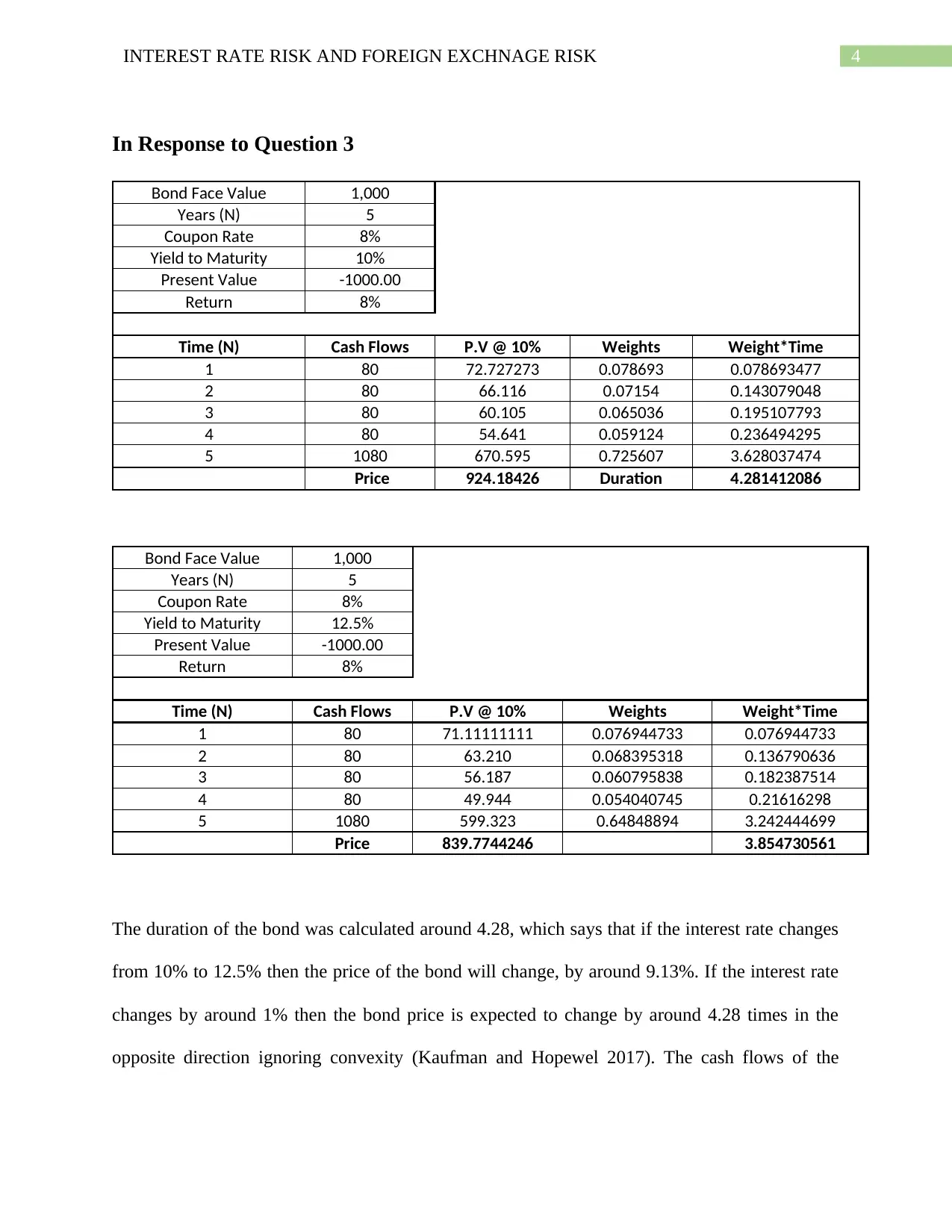
4INTEREST RATE RISK AND FOREIGN EXCHNAGE RISK
In Response to Question 3
Bond Face Value 1,000
Years (N) 5
Coupon Rate 8%
Yield to Maturity 10%
Present Value -1000.00
Return 8%
Time (N) Cash Flows P.V @ 10% Weights Weight*Time
1 80 72.727273 0.078693 0.078693477
2 80 66.116 0.07154 0.143079048
3 80 60.105 0.065036 0.195107793
4 80 54.641 0.059124 0.236494295
5 1080 670.595 0.725607 3.628037474
Price 924.18426 Duration 4.281412086
Bond Face Value 1,000
Years (N) 5
Coupon Rate 8%
Yield to Maturity 12.5%
Present Value -1000.00
Return 8%
Time (N) Cash Flows P.V @ 10% Weights Weight*Time
1 80 71.11111111 0.076944733 0.076944733
2 80 63.210 0.068395318 0.136790636
3 80 56.187 0.060795838 0.182387514
4 80 49.944 0.054040745 0.21616298
5 1080 599.323 0.64848894 3.242444699
Price 839.7744246 3.854730561
The duration of the bond was calculated around 4.28, which says that if the interest rate changes
from 10% to 12.5% then the price of the bond will change, by around 9.13%. If the interest rate
changes by around 1% then the bond price is expected to change by around 4.28 times in the
opposite direction ignoring convexity (Kaufman and Hopewel 2017). The cash flows of the
In Response to Question 3
Bond Face Value 1,000
Years (N) 5
Coupon Rate 8%
Yield to Maturity 10%
Present Value -1000.00
Return 8%
Time (N) Cash Flows P.V @ 10% Weights Weight*Time
1 80 72.727273 0.078693 0.078693477
2 80 66.116 0.07154 0.143079048
3 80 60.105 0.065036 0.195107793
4 80 54.641 0.059124 0.236494295
5 1080 670.595 0.725607 3.628037474
Price 924.18426 Duration 4.281412086
Bond Face Value 1,000
Years (N) 5
Coupon Rate 8%
Yield to Maturity 12.5%
Present Value -1000.00
Return 8%
Time (N) Cash Flows P.V @ 10% Weights Weight*Time
1 80 71.11111111 0.076944733 0.076944733
2 80 63.210 0.068395318 0.136790636
3 80 56.187 0.060795838 0.182387514
4 80 49.944 0.054040745 0.21616298
5 1080 599.323 0.64848894 3.242444699
Price 839.7744246 3.854730561
The duration of the bond was calculated around 4.28, which says that if the interest rate changes
from 10% to 12.5% then the price of the bond will change, by around 9.13%. If the interest rate
changes by around 1% then the bond price is expected to change by around 4.28 times in the
opposite direction ignoring convexity (Kaufman and Hopewel 2017). The cash flows of the
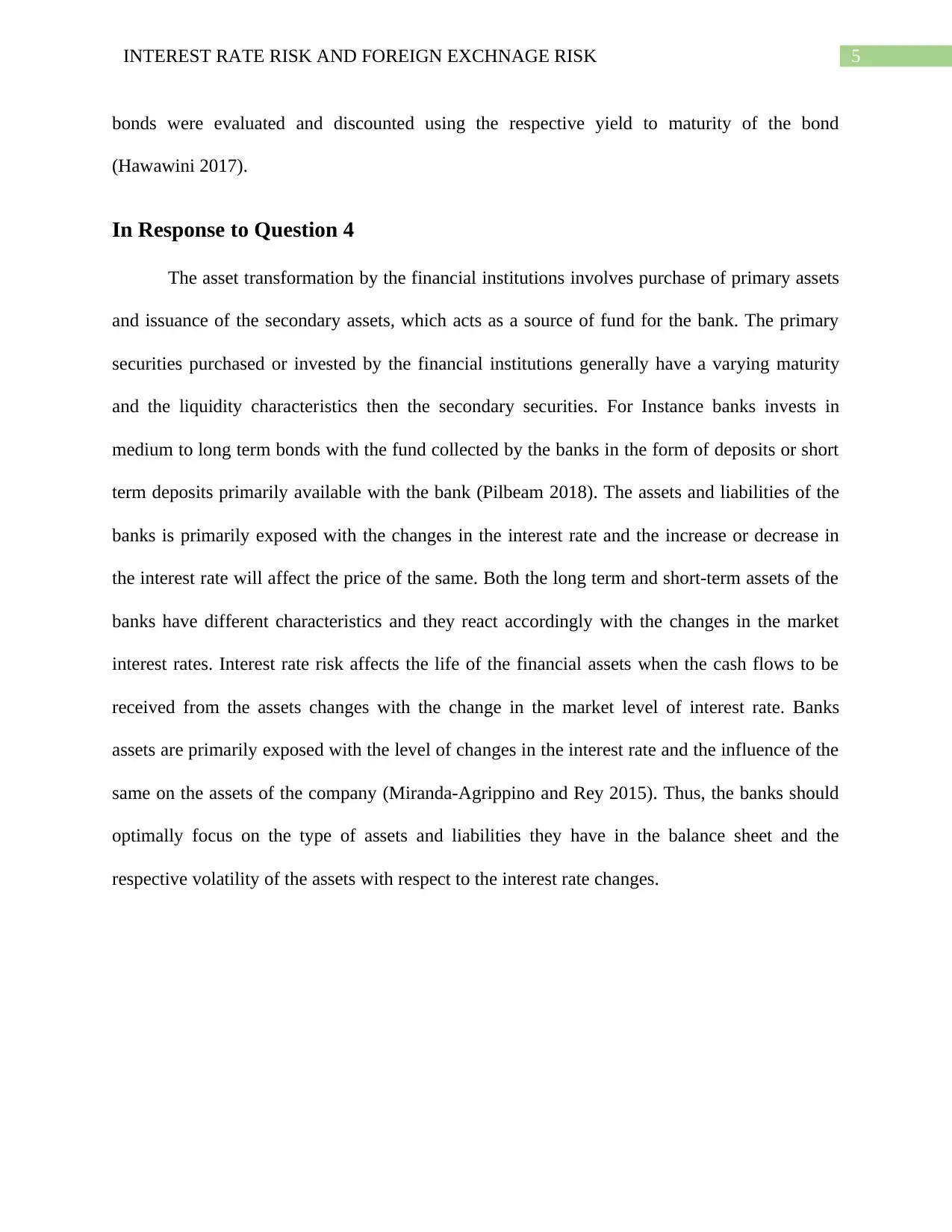
5INTEREST RATE RISK AND FOREIGN EXCHNAGE RISK
bonds were evaluated and discounted using the respective yield to maturity of the bond
(Hawawini 2017).
In Response to Question 4
The asset transformation by the financial institutions involves purchase of primary assets
and issuance of the secondary assets, which acts as a source of fund for the bank. The primary
securities purchased or invested by the financial institutions generally have a varying maturity
and the liquidity characteristics then the secondary securities. For Instance banks invests in
medium to long term bonds with the fund collected by the banks in the form of deposits or short
term deposits primarily available with the bank (Pilbeam 2018). The assets and liabilities of the
banks is primarily exposed with the changes in the interest rate and the increase or decrease in
the interest rate will affect the price of the same. Both the long term and short-term assets of the
banks have different characteristics and they react accordingly with the changes in the market
interest rates. Interest rate risk affects the life of the financial assets when the cash flows to be
received from the assets changes with the change in the market level of interest rate. Banks
assets are primarily exposed with the level of changes in the interest rate and the influence of the
same on the assets of the company (Miranda-Agrippino and Rey 2015). Thus, the banks should
optimally focus on the type of assets and liabilities they have in the balance sheet and the
respective volatility of the assets with respect to the interest rate changes.
bonds were evaluated and discounted using the respective yield to maturity of the bond
(Hawawini 2017).
In Response to Question 4
The asset transformation by the financial institutions involves purchase of primary assets
and issuance of the secondary assets, which acts as a source of fund for the bank. The primary
securities purchased or invested by the financial institutions generally have a varying maturity
and the liquidity characteristics then the secondary securities. For Instance banks invests in
medium to long term bonds with the fund collected by the banks in the form of deposits or short
term deposits primarily available with the bank (Pilbeam 2018). The assets and liabilities of the
banks is primarily exposed with the changes in the interest rate and the increase or decrease in
the interest rate will affect the price of the same. Both the long term and short-term assets of the
banks have different characteristics and they react accordingly with the changes in the market
interest rates. Interest rate risk affects the life of the financial assets when the cash flows to be
received from the assets changes with the change in the market level of interest rate. Banks
assets are primarily exposed with the level of changes in the interest rate and the influence of the
same on the assets of the company (Miranda-Agrippino and Rey 2015). Thus, the banks should
optimally focus on the type of assets and liabilities they have in the balance sheet and the
respective volatility of the assets with respect to the interest rate changes.
⊘ This is a preview!⊘
Do you want full access?
Subscribe today to unlock all pages.

Trusted by 1+ million students worldwide
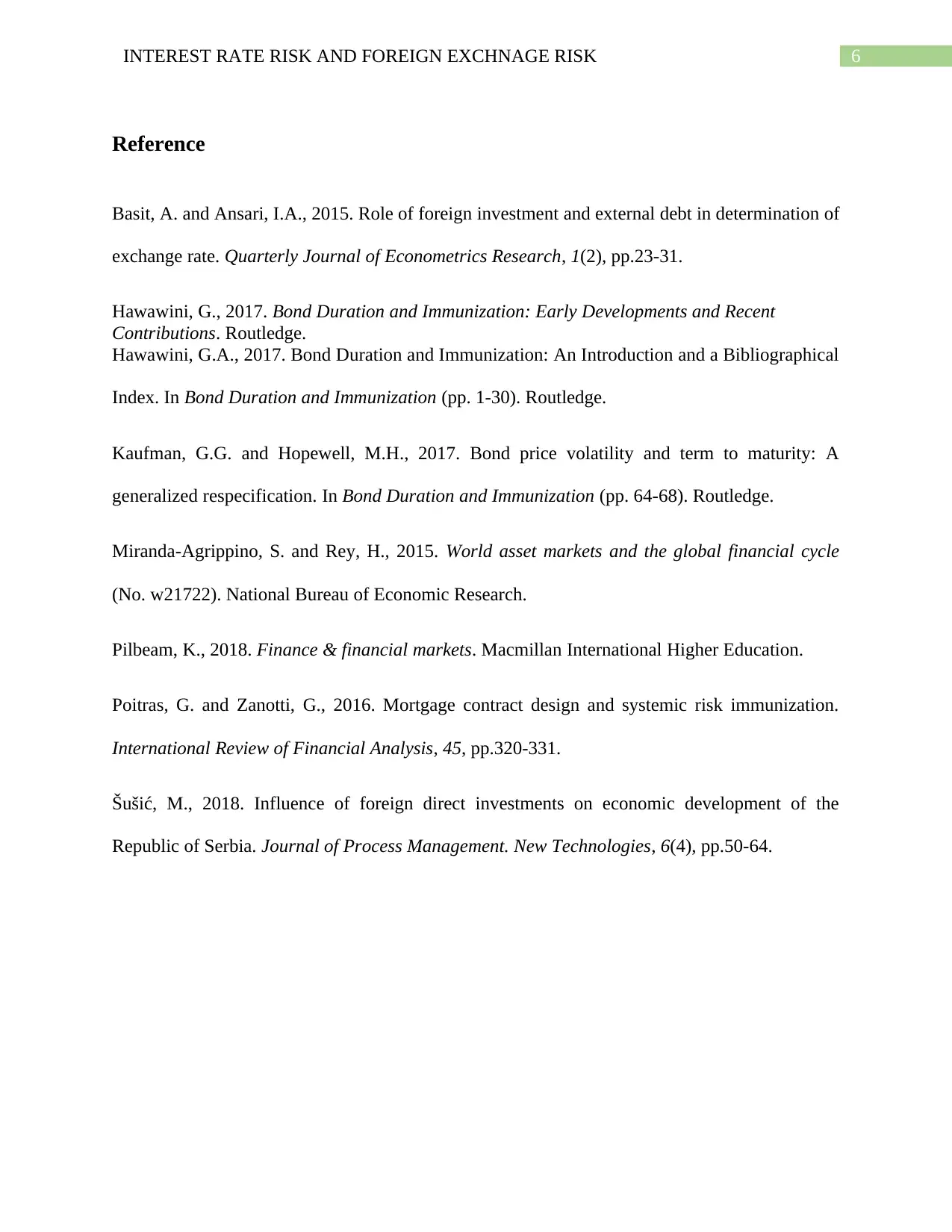
6INTEREST RATE RISK AND FOREIGN EXCHNAGE RISK
Reference
Basit, A. and Ansari, I.A., 2015. Role of foreign investment and external debt in determination of
exchange rate. Quarterly Journal of Econometrics Research, 1(2), pp.23-31.
Hawawini, G., 2017. Bond Duration and Immunization: Early Developments and Recent
Contributions. Routledge.
Hawawini, G.A., 2017. Bond Duration and Immunization: An Introduction and a Bibliographical
Index. In Bond Duration and Immunization (pp. 1-30). Routledge.
Kaufman, G.G. and Hopewell, M.H., 2017. Bond price volatility and term to maturity: A
generalized respecification. In Bond Duration and Immunization (pp. 64-68). Routledge.
Miranda-Agrippino, S. and Rey, H., 2015. World asset markets and the global financial cycle
(No. w21722). National Bureau of Economic Research.
Pilbeam, K., 2018. Finance & financial markets. Macmillan International Higher Education.
Poitras, G. and Zanotti, G., 2016. Mortgage contract design and systemic risk immunization.
International Review of Financial Analysis, 45, pp.320-331.
Šušić, M., 2018. Influence of foreign direct investments on economic development of the
Republic of Serbia. Journal of Process Management. New Technologies, 6(4), pp.50-64.
Reference
Basit, A. and Ansari, I.A., 2015. Role of foreign investment and external debt in determination of
exchange rate. Quarterly Journal of Econometrics Research, 1(2), pp.23-31.
Hawawini, G., 2017. Bond Duration and Immunization: Early Developments and Recent
Contributions. Routledge.
Hawawini, G.A., 2017. Bond Duration and Immunization: An Introduction and a Bibliographical
Index. In Bond Duration and Immunization (pp. 1-30). Routledge.
Kaufman, G.G. and Hopewell, M.H., 2017. Bond price volatility and term to maturity: A
generalized respecification. In Bond Duration and Immunization (pp. 64-68). Routledge.
Miranda-Agrippino, S. and Rey, H., 2015. World asset markets and the global financial cycle
(No. w21722). National Bureau of Economic Research.
Pilbeam, K., 2018. Finance & financial markets. Macmillan International Higher Education.
Poitras, G. and Zanotti, G., 2016. Mortgage contract design and systemic risk immunization.
International Review of Financial Analysis, 45, pp.320-331.
Šušić, M., 2018. Influence of foreign direct investments on economic development of the
Republic of Serbia. Journal of Process Management. New Technologies, 6(4), pp.50-64.
1 out of 7
Related Documents
Your All-in-One AI-Powered Toolkit for Academic Success.
+13062052269
info@desklib.com
Available 24*7 on WhatsApp / Email
![[object Object]](/_next/static/media/star-bottom.7253800d.svg)
Unlock your academic potential
Copyright © 2020–2025 A2Z Services. All Rights Reserved. Developed and managed by ZUCOL.




